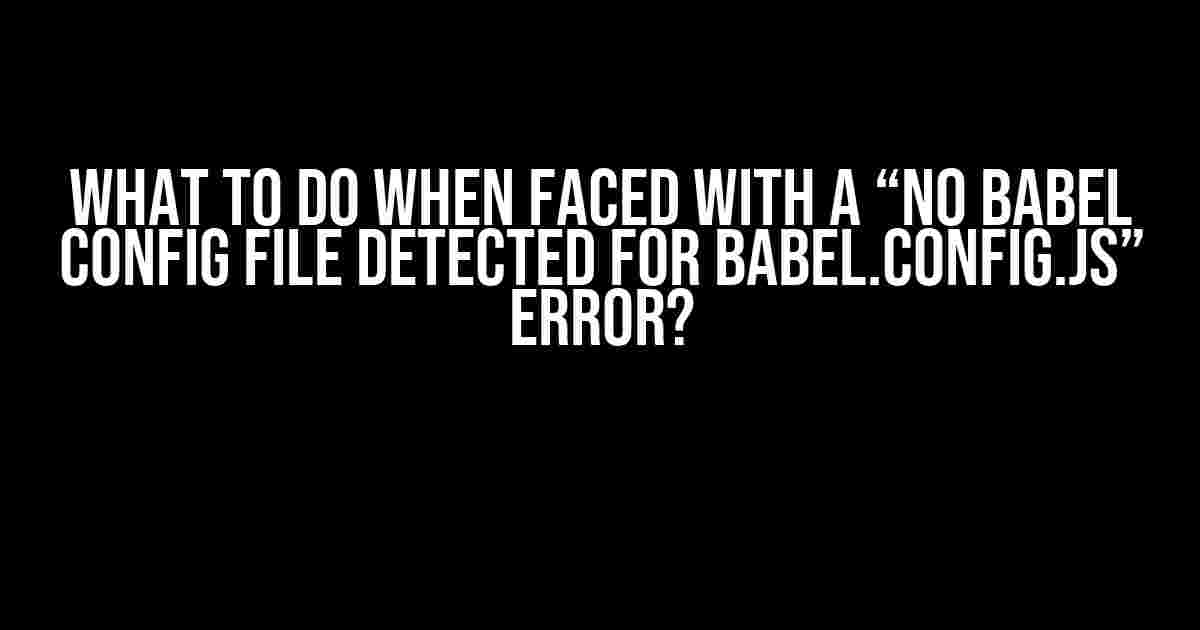If you’re reading this, chances are you’ve stumbled upon the infamous “No Babel config file detected for babel.config.js” error while trying to set up Babel in your project. Don’t worry, you’re not alone! This error can be frustrating, but fear not, for we’re about to dive into the world of Babel configuration and get you back on track in no time.
What is Babel, and why do I need a config file?
Babel is a popular JavaScript transpiler that allows you to write modern JavaScript code and have it converted to older syntax that can be understood by older browsers and environments. Think of it as a time machine for your code! A Babel config file, typically named babel.config.js, is where you define the rules and settings for how Babel should transform your code.
Why do I need a config file, you ask?
A config file serves several purposes:
- Customization**: You can tailor Babel’s behavior to your project’s specific needs, such as specifying which plugins to use, what syntax features to enable, and more.
- Consistency**: A config file ensures that Babel transforms your code consistently across your project, avoiding errors and inconsistencies.
- Reusability**: With a config file, you can reuse your Babel configuration across multiple projects or even share it with others.
The Error: “No Babel config file detected for babel.config.js”
So, what happens when Babel can’t find a config file? Well, it throws an error, complaining that it can’t detect a config file. This error typically occurs when:
- You haven’t created a
babel.config.jsfile in the root of your project. - The file is named incorrectly (e.g.,
babelconfig.jsinstead ofbabel.config.js). - The file is not in the correct location (e.g., it’s buried deep within a subfolder).
- The file is empty or malformed.
Step-by-Step Solution
Don’t worry; fixing this error is relatively straightforward. Follow these steps to create or correct your Babel config file:
Step 1: Create a new file
In the root of your project, create a new file named babel.config.js. Yes, the dot (.) before the filename is important!
// Create a new file: babel.config.js
Step 2: Add basic configuration
Add the following basic configuration to your newly created file:
module.exports = {
// Set the presets and plugins you want to use
presets: [],
plugins: []
};
Step 3: Specify presets and plugins
Time to customize your Babel configuration! Replace the empty arrays with the presets and plugins you need for your project. For example:
module.exports = {
// Set the presets and plugins you want to use
presets: [
'@babel/preset-env',
'@babel/preset-react'
],
plugins: [
'@babel/plugin-transform-runtime'
]
};
In this example, we’re using the @babel/preset-env preset to enable modern JavaScript features and the @babel/preset-react preset for React-specific features. We’re also using the @babel/plugin-transform-runtime plugin to improve performance.
Step 4: Save and retry
Save your babel.config.js file and retry running your Babel command. The error should now be resolved, and Babel should be able to find and use your config file.
Troubleshooting Tips
If you’re still encountering issues, try the following:
- Check the file name and location**: Ensure that your config file is named correctly and located in the root of your project.
- Verify the file contents**: Make sure your config file has the correct syntax and isn’t empty.
- Check for duplicate files**: If you have multiple config files (e.g.,
babel.config.jsonandbabel.config.js), remove or merge them to avoid conflicts. - Upgrade Babel**: If you’re using an older version of Babel, try upgrading to the latest version to ensure compatibility.
Babel Config File Best Practices
To avoid future headaches, follow these best practices for maintaining your Babel config file:
| Best Practice | Why |
|---|---|
| Keep your config file simple | To avoid complexity and make it easier to maintain. |
| Use a consistent naming convention | To avoid confusion and ensure compatibility. |
| Document your config file | To explain the reasoning behind your configuration choices. |
| Test your config file regularly | To catch any errors or inconsistencies early on. |
Conclusion
There you have it! With these steps and tips, you should be able to resolve the “No Babel config file detected for babel.config.js” error and get your project up and running smoothly. Remember to keep your config file organized, well-documented, and regularly tested to avoid future issues. Happy coding!
Still having trouble or have more questions? Feel free to ask in the comments below!
Frequently Asked Question
Oh no! You’re faced with the dreaded “No Babel config file detected for babel.config.js” error. Don’t panic! We’ve got you covered. Here are some FAQs to help you troubleshoot and resolve this issue:
Q1: What is babel.config.js and why is it important?
babel.config.js is a configuration file that tells Babel, a JavaScript transpiler, how to compile your code. It’s essential for Babel to work correctly. Without it, Babel won’t know how to transform your code, leading to errors like the one you’re facing.
Q2: How do I create a babel.config.js file?
Easy peasy! Simply create a new file named babel.config.js in the root of your project directory. You can start with a basic configuration like this: { "presets": ["@babel/preset-env"] }. This tells Babel to use the preset-env preset to compile your code.
Q3: What if I have a babel.config.json file instead?
Babel also supports JSON configuration files! If you have a babel.config.json file, make sure it’s in the correct location (root of your project directory) and formatted correctly. You can also rename it to babel.config.js if you prefer JavaScript configuration files.
Q4: Can I use a babel.config file in a different location?
Yes, you can! Babel looks for configuration files in the current working directory and its ancestors. If you want to use a babel.config file in a different location, you can specify the path using the --config-file or -C option when running Babel.
Q5: What if none of these solutions work?
Don’t worry! If you’ve tried all the above solutions and still encounter issues, it’s time to debug. Check your project’s file structure, configuration files, and Babel versions. You can also search for similar issues on GitHub or Stack Overflow for more specific guidance.



